immobilizer SSANGYONG KORANDO 2012 User Guide
[x] Cancel search | Manufacturer: SSANGYONG, Model Year: 2012, Model line: KORANDO, Model: SSANGYONG KORANDO 2012Pages: 1082, PDF Size: 96.1 MB
Page 598 of 1082
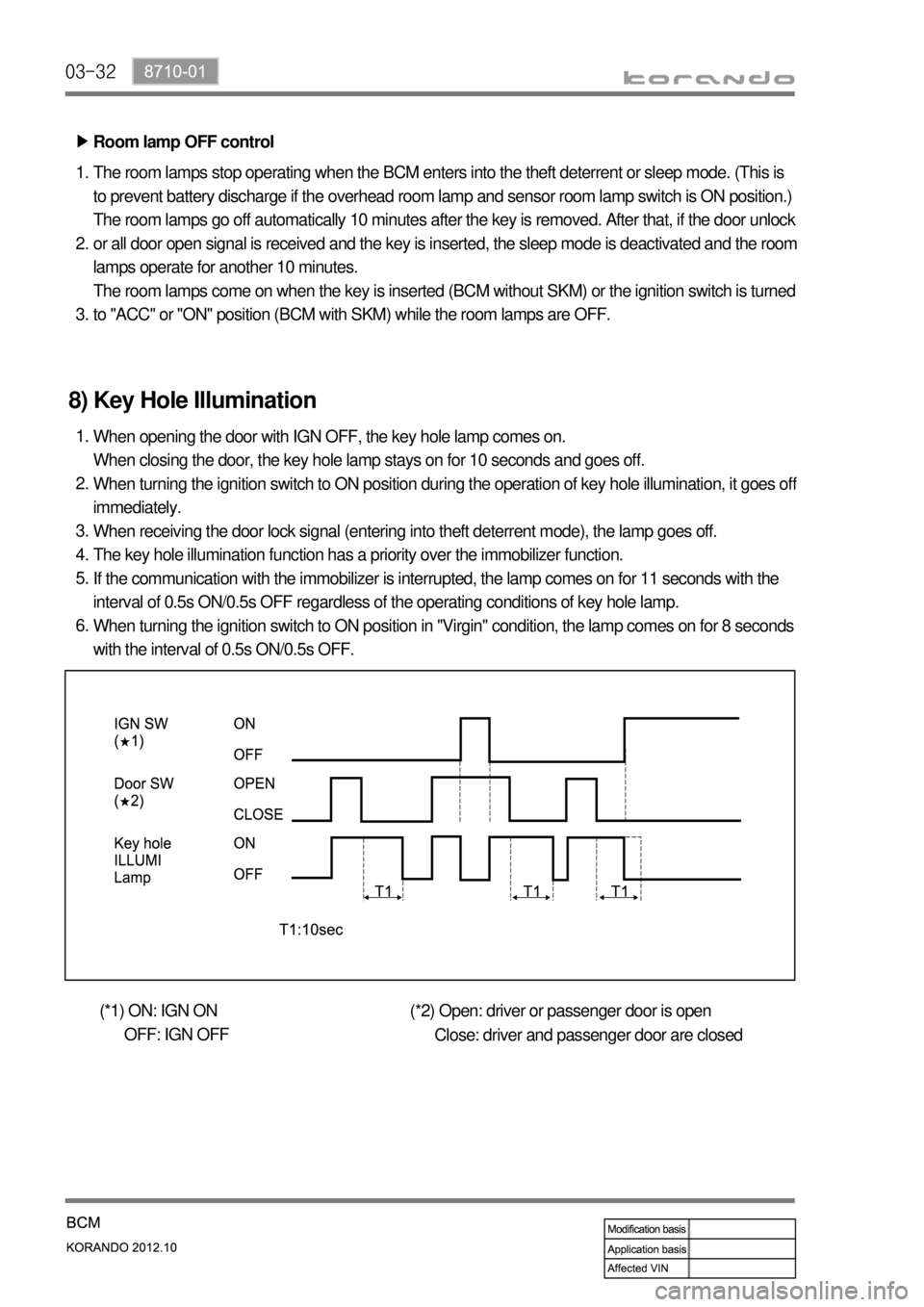
03-32
8) Key Hole Illumination
When opening the door with IGN OFF, the key hole lamp comes on.
When closing the door, the key hole lamp stays on for 10 seconds and goes off.
When turning the ignition switch to ON position during the operation of key hole illumination, it goes of
f
immediately.
When receiving the door lock signal (entering into theft deterrent mode), the lamp goes off.
The key hole illumination function has a priority over the immobilizer function.
If the communication with the immobilizer is interrupted, the lamp comes on for 11 seconds with the
interval of 0.5s ON/0.5s OFF regardless of the operating conditions of key hole lamp.
When turning the ignition switch to ON position in "Virgin" condition, the lamp comes on for 8 seconds
with the interval of 0.5s ON/0.5s OFF. 1.
2.
3.
4.
5.
6.
(*1) ON: IGN ON
OFF: IGN OFF(*2) Open: driver or passenger door is open
Close: driver and passenger door are closed
Room lamp OFF control ▶
The room lamps stop operating when the BCM enters into the theft deterrent or sleep mode. (This is
to prevent battery discharge if the overhead room lamp and sensor room lamp switch is ON position.)
The room lamps go off automatically 10 minutes after the key is removed. After that, if the door unlock
or all door open signal is received and the key is inserted, the sleep mode is deactivated and the room
lamps operate for another 10 minutes.
The room lamps come on when the key is inserted (BCM without SKM) or the ignition switch is turned
to "ACC" or "ON" position (BCM with SKM) while the room lamps are OFF. 1.
2.
3.
Page 616 of 1082
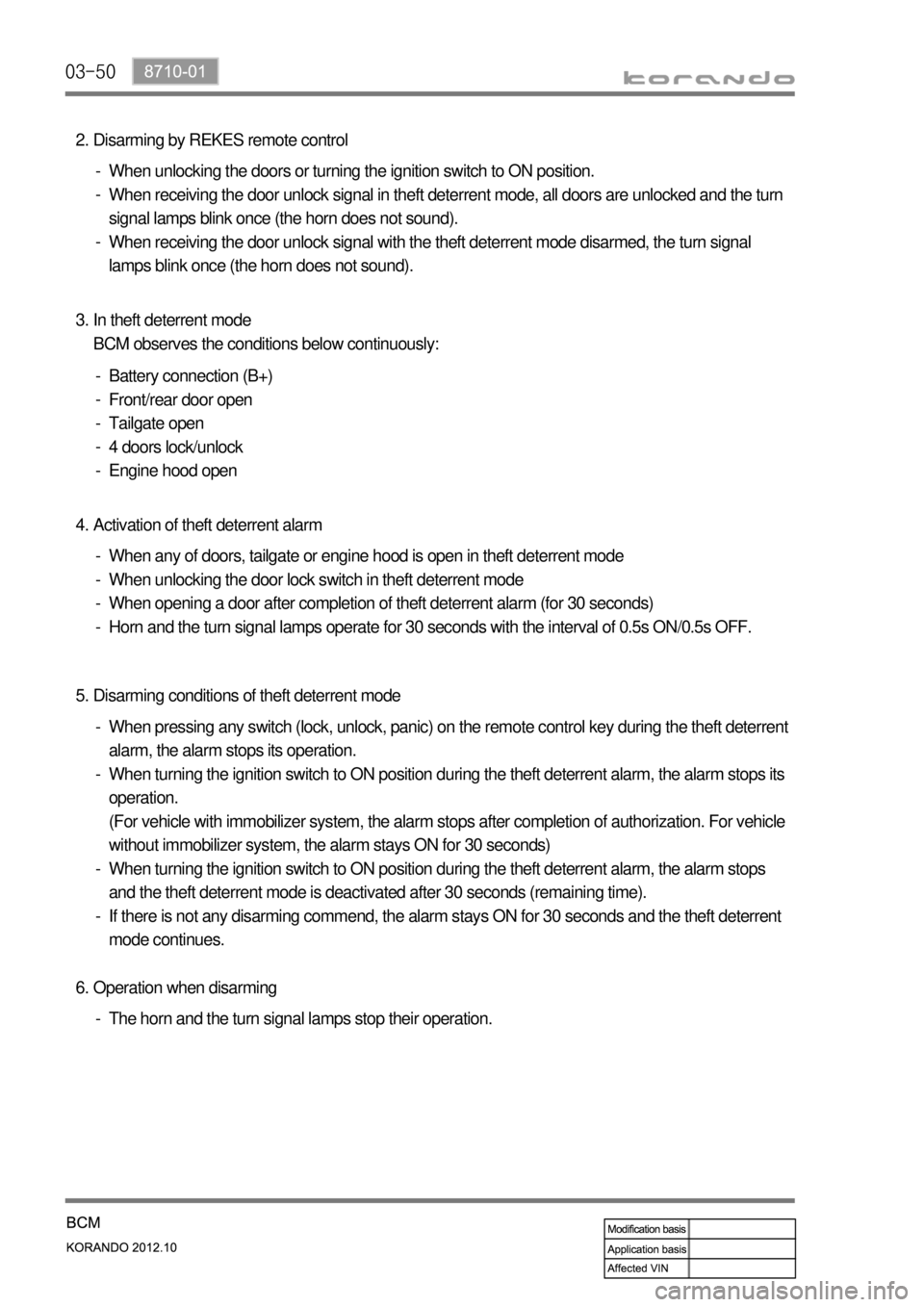
03-50
Disarming by REKES remote control 2.
When unlocking the doors or turning the ignition switch to ON position.
When receiving the door unlock signal in theft deterrent mode, all doors are unlocked and the turn
signal lamps blink once (the horn does not sound).
When receiving the door unlock signal with the theft deterrent mode disarmed, the turn signal
lamps blink once (the horn does not sound). -
-
-
In theft deterrent mode
BCM observes the conditions below continuously: 3.
Battery connection (B+)
Front/rear door open
Tailgate open
4 doors lock/unlock
Engine hood open -
-
-
-
-
Activation of theft deterrent alarm 4.
When any of doors, tailgate or engine hood is open in theft deterrent mode
When unlocking the door lock switch in theft deterrent mode
When opening a door after completion of theft deterrent alarm (for 30 seconds)
Horn and the turn signal lamps operate for 30 seconds with the interval of 0.5s ON/0.5s OFF. -
-
-
-
Disarming conditions of theft deterrent mode 5.
When pressing any switch (lock, unlock, panic) on the remote control key during the theft deterrent
alarm, the alarm stops its operation.
When turning the ignition switch to ON position during the theft deterrent alarm, the alarm stops its
operation.
(For vehicle with immobilizer system, the alarm stops after completion of authorization. For vehicle
without immobilizer system, the alarm stays ON for 30 seconds)
When turning the ignition switch to ON position during the theft deterrent alarm, the alarm stops
and the theft deterrent mode is deactivated after 30 seconds (remaining time).
If there is not any disarming commend, the alarm stays ON for 30 seconds and the theft deterrent
mode continues. -
-
-
-
Operation when disarming 6.
The horn and the turn signal lamps stop their operation. -
Page 634 of 1082
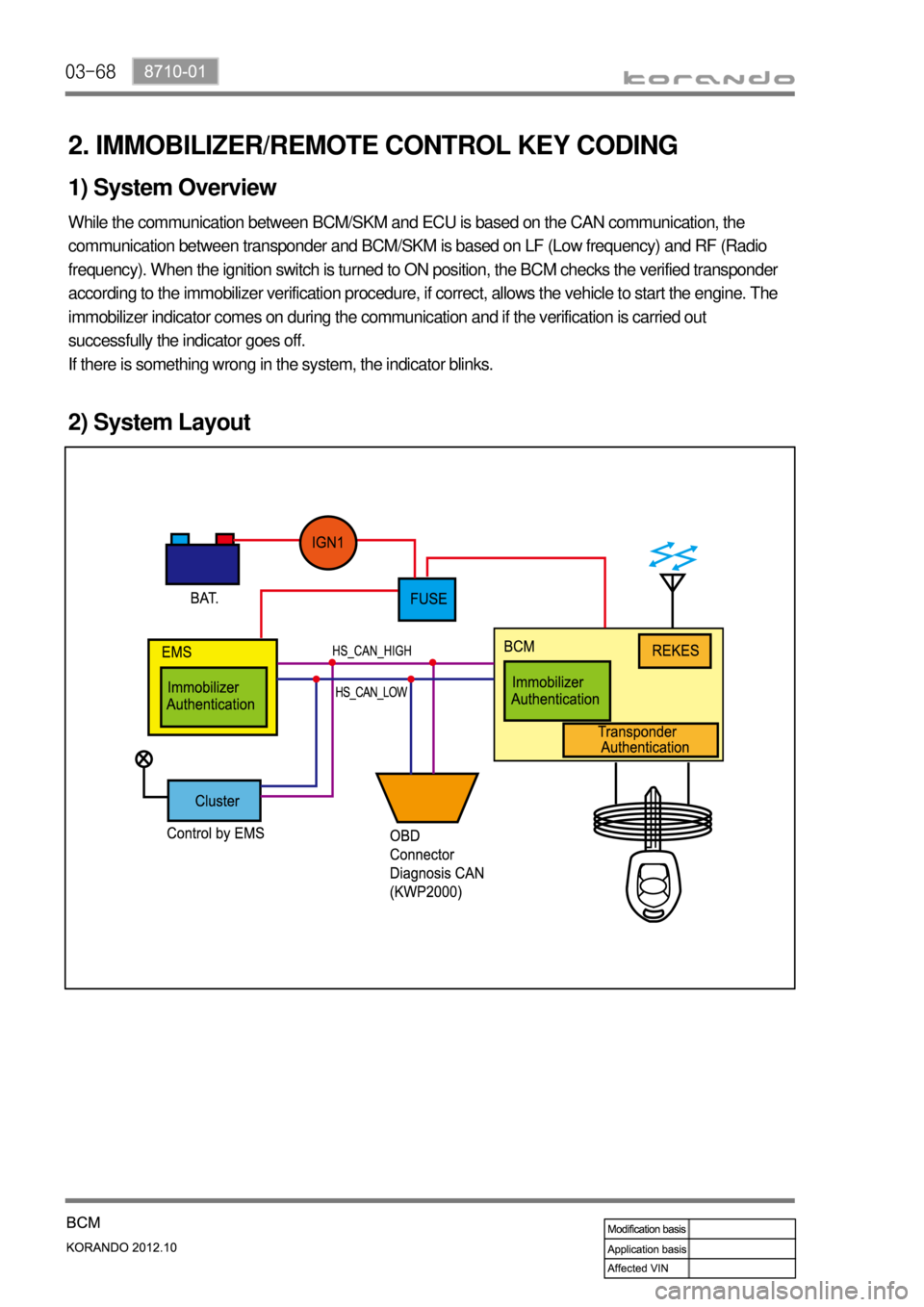
03-68
2. IMMOBILIZER/REMOTE CONTROL KEY CODING
1) System Overview
While the communication between BCM/SKM and ECU is based on the CAN communication, the
communication between transponder and BCM/SKM is based on LF (Low frequency) and RF (Radio
frequency). When the ignition switch is turned to ON position, the BCM checks the verified transponder
according to the immobilizer verification procedure, if correct, allows the vehicle to start the engine. The
immobilizer indicator comes on during the communication and if the verification is carried out
successfully the indicator goes off.
If there is something wrong in the system, the indicator blinks.
2) System Layout
Page 635 of 1082

03-698710-01
3) Operation of Immobilizer
When the ignition switch is turned to the ON position with REKES key, the BCM checks the crypto code
of the inserted key using the immobilizer antenna and sends whether the engine is startable or not to the
engine ECU through the CAN communication so that the engine can be started.
BCM
REKES key
Immobilizer antenna
ECUCAN line
For the vehicle with the immobilizer, there can be a problem in starting the vehicle or the system error:
When two or more immobilizer keys come into contact with (each) other(s).
When the key is close to any device sending or receiving electromagnetic fields or waves other
than Ssangyong products.
When the key is close to any electronic or electric devices such as lighting equipment, security keys
or security cards.
When the key is close to a magnetic or metal object or a battery. -
-
-
-
Page 636 of 1082
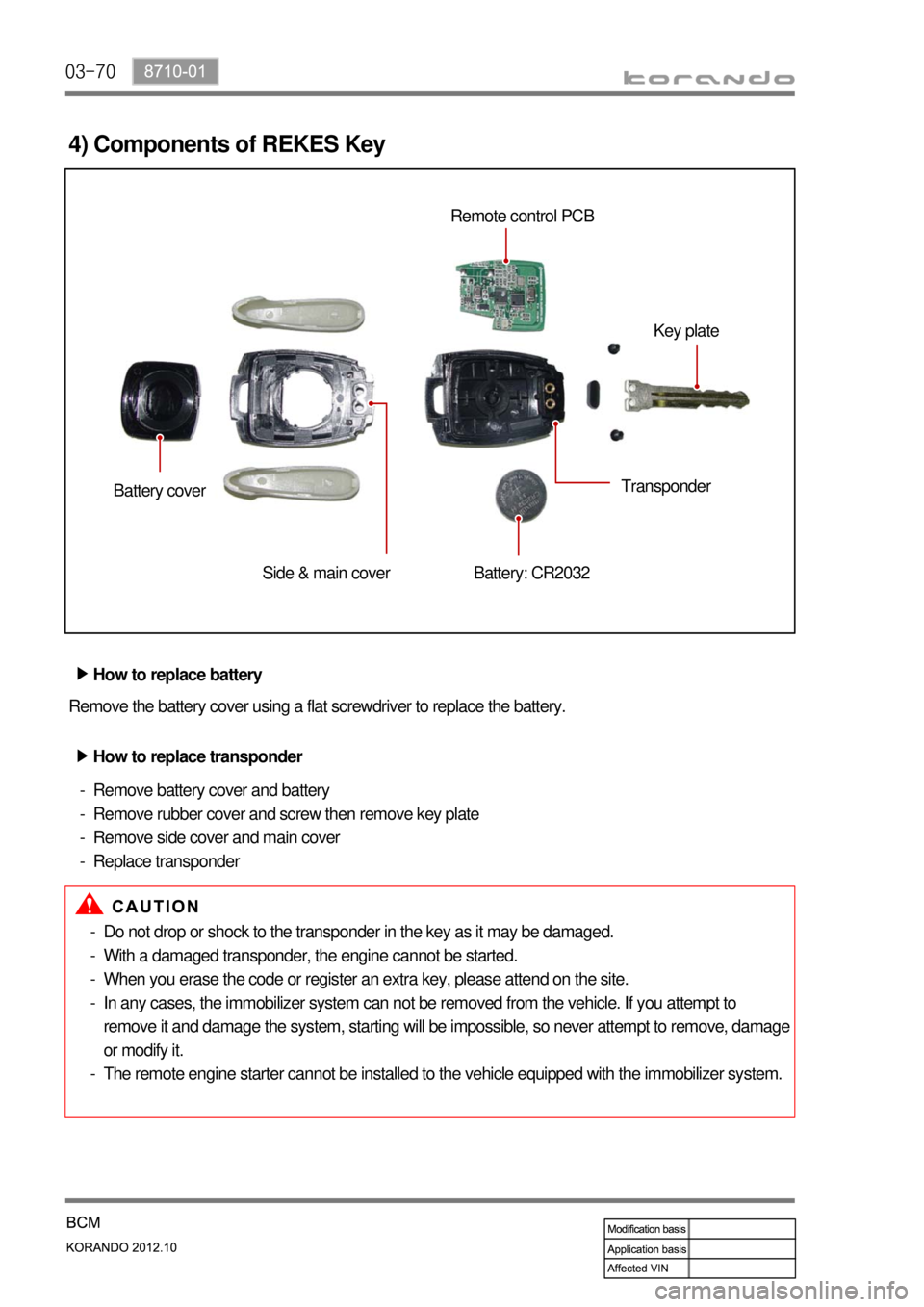
03-70
4) Components of REKES Key
Battery cover
Side & main cover Battery: CR2032TransponderKey plate Remote control PCB
How to replace battery ▶
Remove the battery cover using a flat screwdriver to replace the battery.
How to replace transponder ▶
Remove battery cover and battery
Remove rubber cover and screw then remove key plate
Remove side cover and main cover
Replace transponder -
-
-
-
Do not drop or shock to the transponder in the key as it may be damaged.
With a damaged transponder, the engine cannot be started.
When you erase the code or register an extra key, please attend on the site.
In any cases, the immobilizer system can not be removed from the vehicle. If you attempt to
remove it and damage the system, starting will be impossible, so never attempt to remove, damage
or modify it.
The remote engine starter cannot be installed to the vehicle equipped with the immobilizer system. -
-
-
-
-
Page 653 of 1082

04-198712-03
4) Smart Key Verification Time Control
(1) Pre-verification timer
When the operation signal from the START switch is received, the START & power control functions can
be performed without smart key verification.
(2) Immobilizer verification timer
The immobilizer verification status indicates that it is possible to respond to the request message sent
from the EMS to deactivate the immobilizer. The SKM verified a smart key and the engine can be
started.
The 30-second immobilizer verification time is started when:
the ignition status is changed to IGN by the START switch while the pre-verification timer is activated.
the ignition status is changed to IGN by the smart key verification while the pre-verification timer is
stopped; the SKM verified a smart key by the brake switch signal while the immobilizer verification
timer is stopped or the ignition status is IGN ON.
the SKM verified a smart key successfully if the immobilizer verification timer is stopped with IGN
ON/immobilizer verification /brake switch ON. -
-
-
Condition SKM operation
- when door closed signal is input with - B+ or ACC ON
- when brake is applied with - B+ or ACC ON
- when START switch is operated with - B+
- when smart key is inserted into slot & brake switch is
operated or START switch is operated with - B+Once the vehicle interior verification
is completed, 30 sec. pre-verification
timer is started
when the ignition is turned OFF with IGN ON and engine
running 30 sec. pre-verification timer is
started without re-verification
Timer deactivation conditions: after 30 sec. has passed, IGN ON, Outside door handle switch ON,
entering theft deterrent mode when door condition is changed
IGN1 OFF
30 sec. has passed after immobilizer verification
Any door is opened and then closed when all doors are closed & smart key out
When the engine starts to run, the immobilizer verification status is determined, and the immobilizer will
not be deactivated until the ignition status is changed to IGN/ACC/OFF.
The immobilizer is not deactivated when the key out warning condition is met while the engine is
running. (when the RND is received by the EMS reset while the engine is running)
When attempting to start the engine without immobilizer verification, the system performs smart key
verification procedures, and sends the engine start request to EMS only when the verification result is
normal. -
-
-
*
*
*Entry conditions ▶
Deactivation condition ▶
Page 654 of 1082
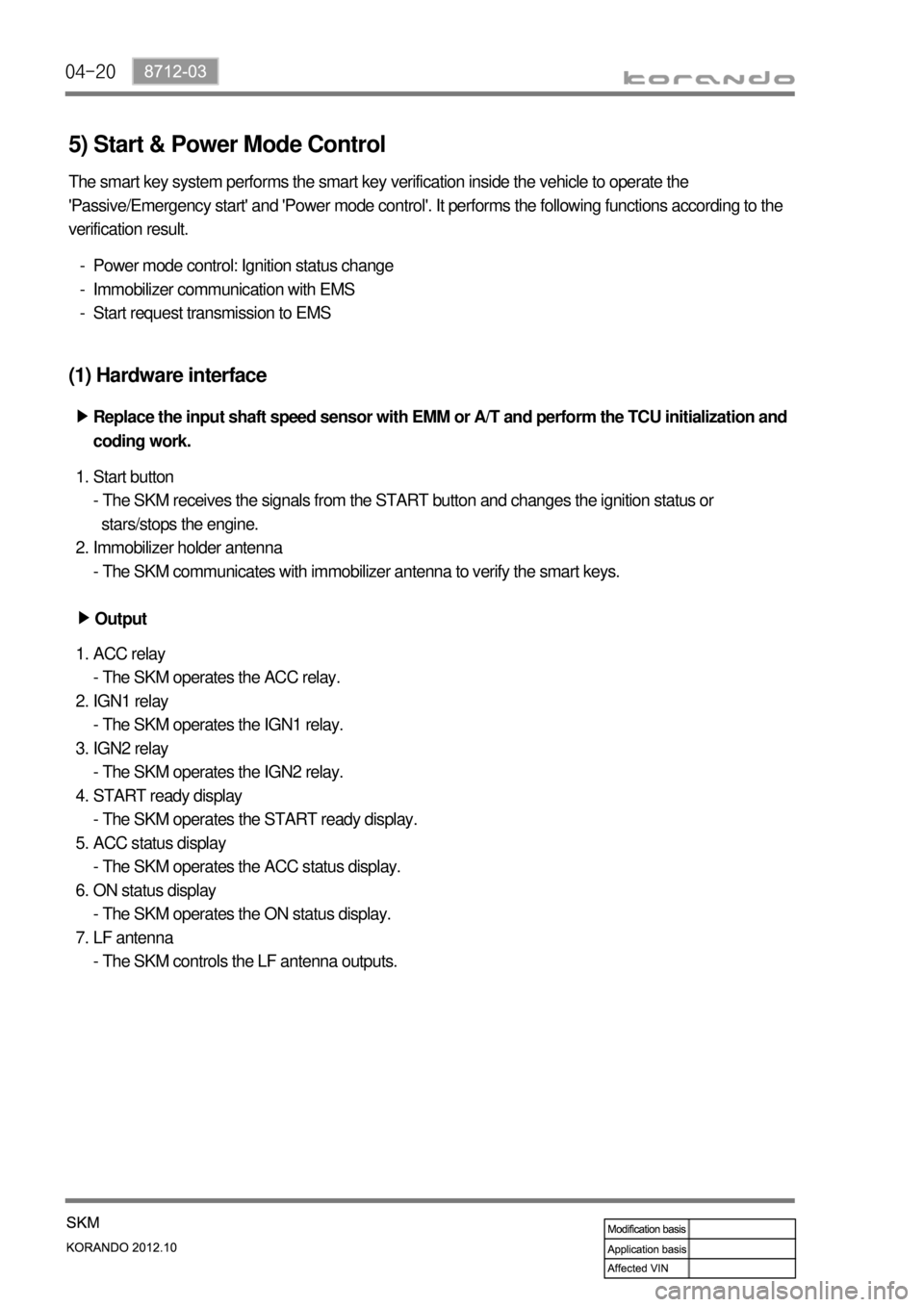
04-20
5) Start & Power Mode Control
The smart key system performs the smart key verification inside the vehicle to operate the
'Passive/Emergency start' and 'Power mode control'. It performs the following functions according to the
verification result.
Power mode control: Ignition status change
Immobilizer communication with EMS
Start request transmission to EMS -
-
-
(1) Hardware interface
Replace the input shaft speed sensor with EMM or A/T and perform the TCU initialization and
coding work. ▶
Start button
- The SKM receives the signals from the START button and changes the ignition status or
stars/stops the engine.
Immobilizer holder antenna
- The SKM communicates with immobilizer antenna to verify the smart keys. 1.
2.
Output ▶
ACC relay
- The SKM operates the ACC relay.
IGN1 relay
- The SKM operates the IGN1 relay.
IGN2 relay
- The SKM operates the IGN2 relay.
START ready display
- The SKM operates the START ready display.
ACC status display
- The SKM operates the ACC status display.
ON status display
- The SKM operates the ON status display.
LF antenna
- The SKM controls the LF antenna outputs. 1.
2.
3.
4.
5.
6.
7.
Page 655 of 1082
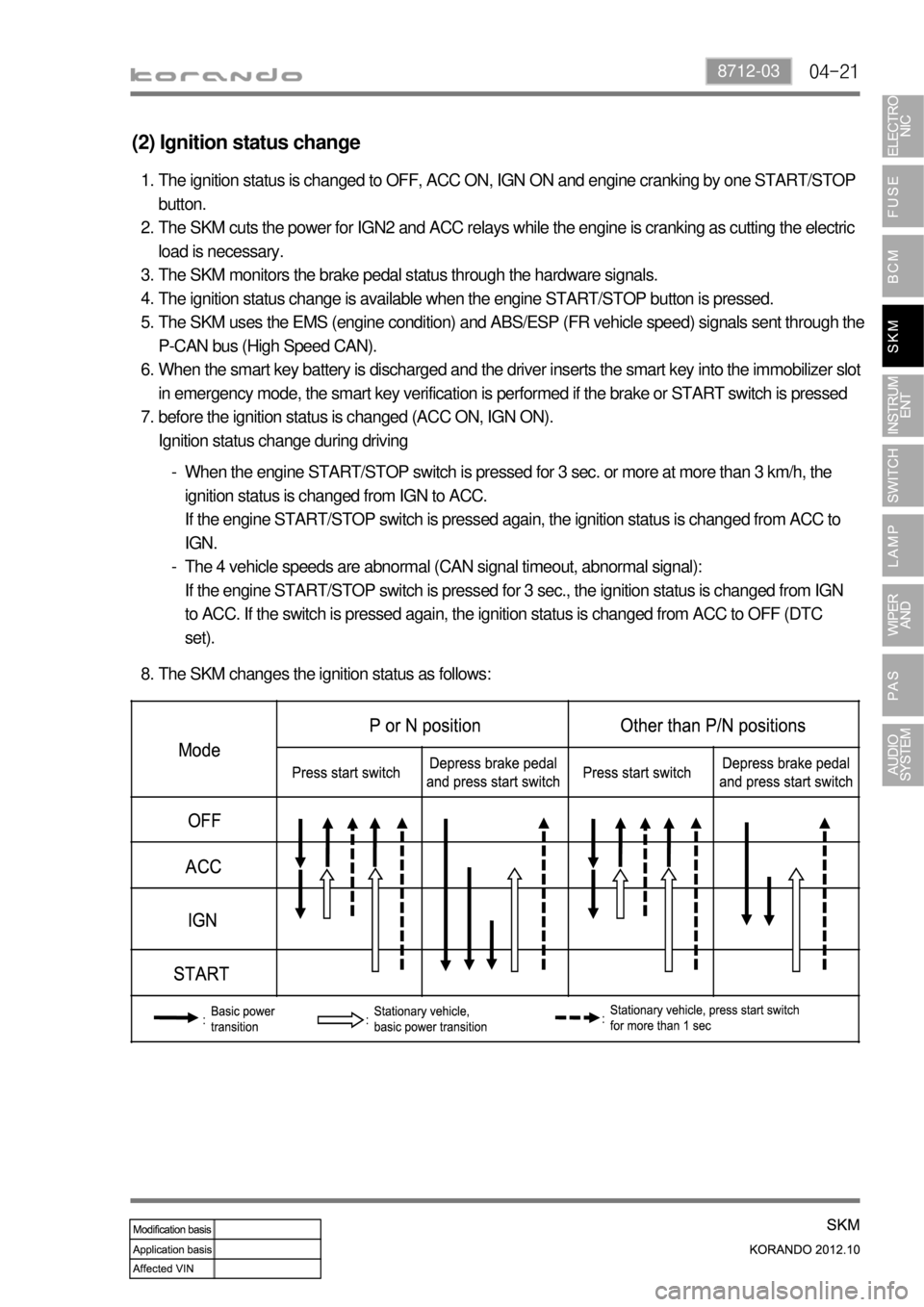
04-218712-03
(2) Ignition status change
The ignition status is changed to OFF, ACC ON, IGN ON and engine cranking by one START/STOP
button.
The SKM cuts the power for IGN2 and ACC relays while the engine is cranking as cutting the electric
load is necessary.
The SKM monitors the brake pedal status through the hardware signals.
The ignition status change is available when the engine START/STOP button is pressed.
The SKM uses the EMS (engine condition) and ABS/ESP (FR vehicle speed) signals sent through the
P-CAN bus (High Speed CAN).
When the smart key battery is discharged and the driver inserts the smart key into the immobilizer slot
in emergency mode, the smart key verification is performed if the brake or START switch is pressed
before the ignition status is changed (ACC ON, IGN ON).
Ignition status change during driving 1.
2.
3.
4.
5.
6.
7.
When the engine START/STOP switch is pressed for 3 sec. or more at more than 3 km/h, the
ignition status is changed from IGN to ACC.
If the engine START/STOP switch is pressed again, the ignition status is changed from ACC to
IGN.
The 4 vehicle speeds are abnormal (CAN signal timeout, abnormal signal):
If the engine START/STOP switch is pressed for 3 sec., the ignition status is changed from IGN
to ACC. If the switch is pressed again, the ignition status is changed from ACC to OFF (DTC
set). -
-
The SKM changes the ignition status as follows: 8.
Page 656 of 1082

04-22
When the ignition status is changed, the SKM communicates according to the body network
conditions as follows: 9.
OFF → ACC: Keep communicating for 5 sec.
OFF → IGN: Keep communicating
ACC → IGN: Keep communicating
IGN → Cranking: Keep communicating
Cranking→ IGN: Keep communicating
IGN → ACC: Keep communicating for 5 sec.
ACC → OFF: Keep communicating for 5 sec.
IGN → OFF: Keep communicating for 5 sec. -
-
-
-
-
-
-
-
(3) Engine start
When the START button is pressed with the brake pedal applied and gear selector lever in P or N
position, the SKM performs the immobilizer verification and sends the engine START request signal
to the EMS if a normal coded smart key is found.
When the .engine start request signal from the START switch is received, the SKM sends the start
request signal through the PCAN and the smart key location signal through the BCAN to crank the
engine.
The SKM cuts the power for IGN2 and ACC relays while the engine is cranking as cutting the electric
load is necessary.
The SKM receives the engine start status signal from the EMS through the PCAN.
The SKM turns on the ACC/IGN2 relays after the engine cranking and sends the signal for [IGN after
starting] through BCAN.
When the START button is pressed and engine cranking request1 signal is sent, the EMS cranks the
engine after checking the engine warming up. If the engine cranking request2 signal is sent, the EMS
cranks the engine without checking the engine warming up. 1.
2.
3.
4.
5.
6.
Engine cranking request1:
When the START switch is pressed briefly under a normal condition
Engine cranking request2:
When the START switch is pressed once again while the engine cranking request1 signal is sent,
OR When the START switch is pressed for 3 sec. or more -
-
Starting engine while driving 7.
The engine start request signal is sent when the START switch is pressed, provided that the
vehicle speed is less than 10 Km/h or no vehicle speed signal is input, the gear selector lever is in
N position and the brake switch is ON with IGN ON (30 sec. verification is not required).
The engine start request signal is sent regardless of the brake signal when the START switch is
pressed, provided that the vehicle speed is 10 Km/h or more and the gear selector lever is in N
position with IGN ON (30 sec. verification is not required). -
-
Page 662 of 1082
![SSANGYONG KORANDO 2012 User Guide 04-28
Smart key not found warning deactivation conditions
If below conditions are met, the SKM sends the signal for [Smart key not found warning
deactivation] to deactivate the warning. -
A smart key SSANGYONG KORANDO 2012 User Guide 04-28
Smart key not found warning deactivation conditions
If below conditions are met, the SKM sends the signal for [Smart key not found warning
deactivation] to deactivate the warning. -
A smart key](/img/67/57504/w960_57504-661.png)
04-28
Smart key not found warning deactivation conditions
If below conditions are met, the SKM sends the signal for [Smart key not found warning
deactivation] to deactivate the warning. -
A smart key is found while the smart not found warning signal is output.
2.
(2) Smart key detection warning
When a valid smart key sends the LOCK signal from outside of the vehicle or the outside door handle
switch is pressed with no smart key outside, the smart key detection warning signal is output, provided
that all the doors or the tailgate is closed with IGN OFF or ACC ON and a smart key is in the vehicle.
Smart key detection warning conditions ▶
When a valid smart key sends the LOCK signal from outside of the vehicle, the SKM sends the signals
for [external buzzer] and [smart key detection warning] to the BCM and instrument cluster through the
BCAN to inform the driver of the existence of a verified key inside the vehicle, provided that all the doors
or the tailgate is closed with IGN OFF or ACC ON and a smart key is in the vehicle.
Smart key inside vehicle warning 2.
If a smart key including immobilizer slot is identified as being in the vehicle after the outside door handle
switch is pressed, the SKM sends the signals for [external buzzer] and [smart key detection warning] to
the BCM and instrument cluster through the BCAN to inform the driver of the existence of a verified key
inside the vehicle.
These 2 warnings (external buzzer, smart key detection warning) continue for up to 10 sec. until the
warning conditions are deactivated under the above conditions.
The SKM stops these warnings immediately after the warning conditions are deactivated. -
Smart key detection warning deactivation conditions ▶Deactivation warning 1.
Function stop warning deactivation conditions 1.
When theft deterrent deactivated
The SKM sends the signals for [external buzzer] and [smart key detection warning
deactivation].
Smart key inside vehicle warning deactivation conditions
When the door is opened and then closed and no smart key is found, the SKM sends the
signals for [external buzzer] and [smart key detection warning deactivation]. -
-